City of Melbourne and Environs
On our figure-of-eight tour of Victoria, our last destination was the City of Melbourne and Environs. So, we made an early start from Meeniyan to drive to our hotel in South Melbourne; for a three-night stay. On the way, we stopped for most of the day at Royal Botanic Gardens Cranbourne.
Royal Botanic Gardens Cranbourne
The garden at Cranbourne has two distinctly different areas: a formal Australian Garden specialising in Australian native species and a second featuring Victoria native heathland, wetlands, and grasslands. The two provide contrasting environments for nature and wildlife photography.
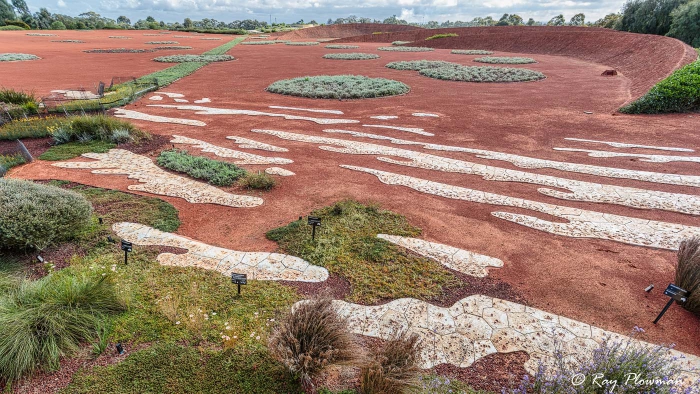
Red Sand Garden
Red Sand Garden in the Australian Garden at Royal Botanic Gardens Cranbourne.
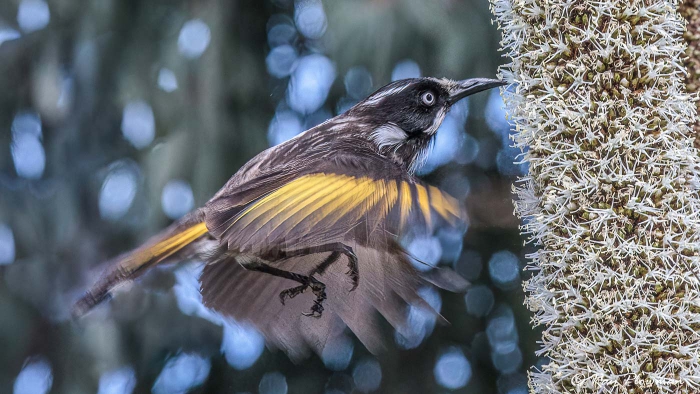
New Holland Honeyeater
New Holland Honeyeater (Phylidonyris novaehollandiae) flying to grass-tree at Royal Botanical Gardens Cranbourne.
Australian Garden in Royal Botanic Gardens Cranbourne
[foogallery id=”18004″]
During the morning, we visited the Australian Garden to view the Red Sand Garden and the surrounding themed gardens. First, we wandered around the themed gardens alongside the Rockpool Waterway. Although I photographed some plants, most were from other Australian states, so I have excluded them from the gallery. However, I have included the Red Sand Garden landscape. Also, a pair of New Holland honeyeaters feeding on nectar and a Watering Can Sculpture.
Then, we backtracked to visit the gardens alongside the Dry Riverbed and photographed a common Red Wattlebird. We stopped at the grass trees area, sitting and photographing nectar-feeding bird species. After our afternoon bushwalk, we returned to the grass tree area to photograph more birds feeding on the nectar.
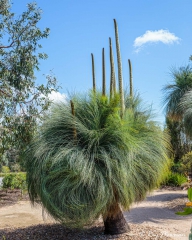
The Australian native grass trees (Xanthorrhoea australis) were magnets for honeyeaters and honeybees. New Holland honeyeaters and little wattlebirds were frequent visitors and an occasional appearance of a male Scarlet Myzomela.
Honeyeaters feed on nectar, obtained using a long brush-tipped tongue, specially adapted to probe deep into flowers. They also forage for insects, flowers, berries and some seeds. While a little wattlebird was feeding on nectar, a honeybee came close, providing the bird with a welcomed snack.
Bushland Trails at Royal Botanic Gardens Cranbourne
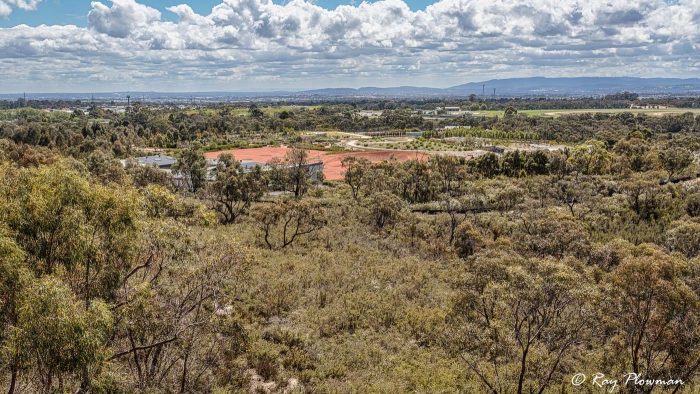
Australian Garden from Trig Point
Australian Garden from Trig Point Lookout at Royal Botanical Gardens Cranbourne.
[foogallery id=”18009″]
The native bushland at Cranbourne features natural grassland, heathland, wetlands and woodland areas. So, after lunch, we took a relatively easy circular 4.4 km bushwalk starting at the car park. We followed Trig Track through heathland, where I photographed a Jacky Lizard along the trail. At Trig Point Lookout, I photographed two landscape panoramas, one looking north to the Australian Garden and the other south. Then we continued along Trig Track to Perched Swamp for a brief stop. We spotted a red-necked wallaby in the grassy woodland, the first several along the walk. Next, a right onto Lake Track 1 and then right onto Wylies Creek Track, finishing back at the carpark. Finally, back to the Australian Garden for a second visit before heading to our hotel in South Melbourne.
Moreover, mainland red-necked wallabies are subspecies Macropus rufogriseus banksianus, while the nominate subspecies M.r. rufogriseus are Tasmanian Bennetts wallabies.
Melbourne City
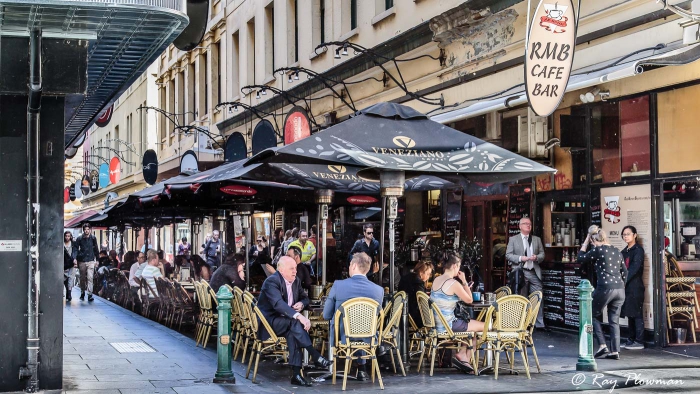
Laneways Cafe Culture
The RMB Cafe Bar on Degraves Street is part of the laneways cafe culture.
[foogallery id=”18014″]
Like most big cities, Melbourne and its suburbs suffer from traffic congestion. So, choosing a suitable location was essential to avoid wasting time in traffic jams. Therefore, we decided to stay at Buckingham International in Highett, City of Kingston, South Melbourne.
So, we set off early the next day to avoid traffic and take advantage of the early-bird parking in Melbourne. We parked at the Arts Centre Carpark on Southbank, where we started our city circular walking tour. First, along Southbank Promenade, crossing the Yarra at the Sandridge Rail Bridge, Finders Walk to Flinders Street Station. Next, through the laneways (Degraves Street, Centre, and Block Place) and shopping arcades (Block and Royal) to Chinatown. Time for a rest and lunch at Paramount Food Court. Then, we made a brief visit to the Royal Botanic Gardens in the afternoon.
Mornington Peninsula – Briars Wildlife Sanctuary
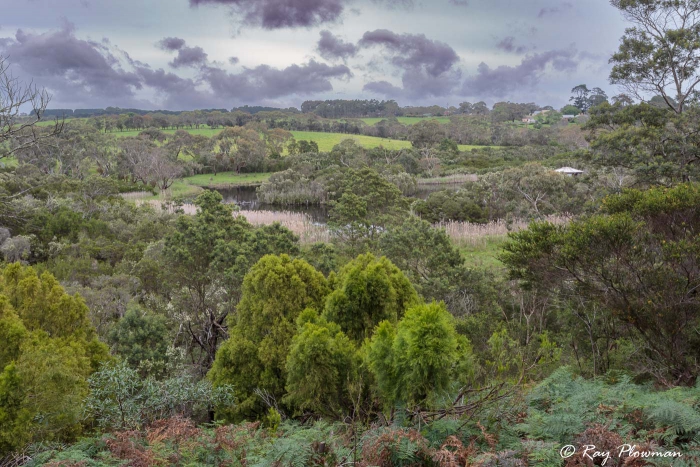
Briars Wildlife Sanctuary
Briars Wildlife Sanctuary from the wetlands viewpoint at Woodland/Ker-Bur-Rer footpaths, Mornington Peninsula.
[foogallery id=”18021″]
We drove to the Briars Wildlife Sanctuary at Mornington Peninsula on our second day in Melbourne, arriving mid-morning.
Our first walk was short and easy-going through the wetlands to visit the Boonoorong and Chechingurk Hides. Birds photographed on this walk included a black swan nesting near Chechingurk Hide. And, at the Boonoorong Hide, female and male fairy-wrens flying vigorously against the glass before collapsing. Both seemed to recover and were up flying again. I assume defensive behaviour due to birds seeing reflections in the window glass – it was dark inside the hide. Because of scratched and dirty glass, most behaviour photos were of inferior quality. So, I have only included one decent quality image in the gallery: a female fairy-wren.
Next, we took a stroll around the 4 km Woodlands and Ker-Bur-Rer and tracks. A Wetlands Viewpoint is at the junction of the Woodlands Walk, Ker-Bur-Rer Walk, and Tichin Goroke Link path. After photographing the viewpoint panorama, we continued Ker-Bur-Rer Walk spotting an eastern yellow robin and golden whistler.
We planned some walks in the afternoon, but we just followed a couple of scenic drives because of inclement weather.
Bayside and Albert Park
On our third and final day in Melbourne, we took a scenic drive to the airport. From Highett, we joined route 33 at Half Moon Bay, then to Sandringham Jetty and Foreshore Reserve stopping at each. Next, we stopped at Albert Park before driving to the airport for lunch and our flight to Hobart in Tasmania.
Continue the 2013 Tour to Tasmania
We flew from Melbourne to Hobart in Tasmania; ‘Next’ continue to the Tasmania webpage.
Or ‘VIC’ to go to the Nature and Wildlife in Victoria, Australia webpage.
Bibliography – Online Resources
1. Royal Botanic Gardens Victoria. No date. [Online] Available from https://www.rbg.vic.gov.au/ [Accessed 17-Marl-22].
2. The Best Laneways in Melbourne. No date. [Online] Available from https://www.discovera.com.au/melbourne/ [Accessed 17-Marl-22].
3. The Best Arcades in Melbourne. No date. [Online] Available from https://www.discovera.com.au/melbourne/ [Accessed 17-Marl-22].
4. Beautiful walks at The Briars. No date. [Online] Available from https://www.mornpen.vic.gov.au/ [Accessed 17-Marl-22].